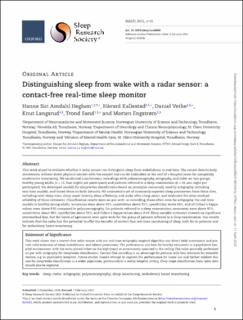| dc.description.abstract | This work aimed to evaluate whether a radar sensor can distinguish sleep from wakefulness in real time. The sensor detects body movements without direct physical contact with the subject and can be embedded in the roof of a hospital room for completely unobtrusive monitoring. We conducted simultaneous recordings with polysomnography, actigraphy, and radar on two groups: healthy young adults (n = 12, four nights per participant) and patients referred to a sleep examination (n = 28, one night per participant). We developed models for sleep/wake classification based on principles commonly used by actigraphy, including real-time models, and tested them on both datasets. We estimated a set of commonly reported sleep parameters from these data, including total-sleep-time, sleep-onset-latency, sleep-efficiency, and wake-after-sleep-onset, and evaluated the inter-method reliability of these estimates. Classification results were on-par with, or exceeding, those often seen for actigraphy. For real-time models in healthy young adults, accuracies were above 92%, sensitivities above 95%, specificities above 83%, and all Cohen's kappa values were above 0.81 compared to polysomnography. For patients referred to a sleep examination, accuracies were above 81%, sensitivities about 89%, specificities above 53%, and Cohen's kappa values above 0.44. Sleep variable estimates showed no significant intermethod bias, but the limits of agreement were quite wide for the group of patients referred to a sleep examination. Our results indicate that the radar has the potential to offer the benefits of contact-free real-time monitoring of sleep, both for in-patients and for ambulatory home monitoring. | en_US |

